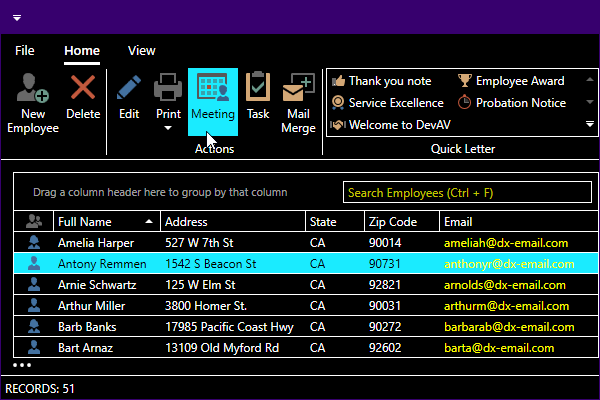
- Devexpress wpf themes how to#
- Devexpress wpf themes install#
- Devexpress wpf themes full#
- Devexpress wpf themes code#
- Devexpress wpf themes download#
If you use their skins already then pick those that you use as a base when saving your own custom theme. You can read instructions on using the tool here.
Devexpress wpf themes download#
But first, you will need to switch to a custom theme which you will create using the DevEpxress Theme Editor, which you can download here. I will show how you can modify their grid’s column heading template to inject your own Attached Properties which you can then set in your Xaml. Unfortunately, this exercise is not for the faint-hearted, as it requires switching your WPF project to use a custom theme that you will create using their tool. I recently was asked to color the background of the Grid Headers and decided I would share my pain and the solution here. If you are working with their GridControl, you probably noticed how notoriously difficult it is to certain things you thought should be a lot easier.

But I don’t want to advertize them too much here. Their library of widgets is widely used in many financial firms to speed up time to market and make UI development easier.
Devexpress wpf themes full#
NET control providers offering a full suite of controls for WPF. I'd love to hear from you - please share your thoughts on our WPF Theme Designer using the comments field below.DevExpress is one of several 3rd party. If you are ready to customize an existing WPF theme and want to learn more, please refer to the following online resources: Theme.AssemblyName = ".v17.2" ĪpplicationThemeHelper.ApplicationThemeName = "TestTheme"
Devexpress wpf themes code#
And add a few lines of code to the file. To apply the new theme to an application, I'll need to build the assembly by clicking the Publish button and add a reference to this assembly within my application project. I use the Color Editor to set the Backstage.Delimiter, Backstage.HoverBackground and Backstage.SelectionBackground palette colors by modifying the tone and saturation of the color value. Note that by changing the palette color, I set a new value for all 81 occurrences of this color within different DevExpress controls: the Ribbon's background in the Ribbon, Diagram Designer and Spreadsheet controls, the background of the Hamburger Menu, etc. I'll use it to pick the color (green) used within Microsoft Excel. The Theme Designer's built-in Color Picker allows me to select any on-screen color. Once I know what I need to modify, it's time to select the new color. To double-check, I click the Highlight Colors tool and select this palette color to highlight all affected elements. If you're following along, you'll notice that I must modify the color.

To obtain the name of the required palette color, I select the Filter Colors tool and point to the ribbon background area while holding the SHIFT key. The next step is to change the background color of the DevExpress Ribbon and Hamburger Menu to mimic the appearance of Microsoft Excel. This reduces the amount of work involved in customizing them and helps maintain overall consistency. Note that changing a palette color automatically sets a new value for all corresponding individual colors. I can group them to see which colors are included within the palette. The Individual Colors tab on the right panel includes thousands of colors. The Palette tab for the Office 2016 Colorful theme includes 29 colors. The panel on the right displays the theme's palette (combines colors used by different controls). Next, I'll select a DevExpress control on the left panel to preview its color scheme. To begin, I will build my project by pressing the F6 key or by clicking the Build Ribbon button. My objective in this blog post is to take the DevExpress Office 2016 Colorful theme and modify a couple of its colors so that it is more in line with Microsoft Excel. Though you can always build a theme from scratch, it's best to start with a theme that offers you most of what you need. Once you've installed the Theme Designer, you are ready to explore its capabilities.
Devexpress wpf themes install#
To customize existing DevExpress themes, you'll need to download the Theme Designer and install it on your machine: It is a free standalone tool that allows you to generate custom themes by altering the base colors of existing DevExpress Themes for the WPF platform. The DevExpress WPF Theme Designer was designed to reduce the grunt work associated with custom app-wide theme development.
Devexpress wpf themes how to#
In this blog post, I will demonstrate how to quickly customize an existing DevExpress WPF theme and how you and your team can leverage our WPF Theme Designer to tailor the look and feel of WPF apps you deliver to end-users. Without the proper tools, creating your own custom theme can be incredibly tedious and time consuming process - a process that very few people willingly tackle. As you know, a typical app-wide color scheme consists of numerous palettes/colors/shades.


 0 kommentar(er)
0 kommentar(er)
